How to Measure Your Emotional Growth Over Time
💡 Introduction: Emotional Growth Is Invisible—Until You Measure It
You’ve probably heard phrases like “I’ve grown a lot emotionally” or “I’m not the same person I used to be.”
But what does that actually mean?
Emotional growth isn’t about never feeling sad, angry, or anxious again.
It’s about how quickly you recover, how consciously you respond, and how much awareness you bring to your internal world.
The challenge is that progress in emotional maturity is often subtle.
You can’t weigh it or chart it like weight loss or financial success.
But that doesn’t mean it’s unmeasurable.
This guide will help you build a framework to track your emotional growth over time — using psychology, self-reflection, and even biofeedback science to translate inner transformation into something visible, trackable, and empowering.
Looking for supplements for This? Click here.
🧠 Part 1: What Emotional Growth Really Means
🌿 The Core Definition
Emotional growth is the process of becoming more aware of your feelings, more regulated in your reactions, and more compassionate toward yourself and others.
It’s not about avoiding pain — it’s about learning how to carry it with wisdom.
Psychologists define emotional growth as the development of three interlinked capacities:
1️⃣ Emotional awareness — recognizing your emotions in real time
2️⃣ Emotional regulation — responding with control instead of impulse
3️⃣ Emotional integration — learning from experiences instead of repeating them
🧩 The Stages of Emotional Development
You can think of emotional growth as a spectrum:
| Stage | Description | Common Markers |
|---|---|---|
| 1️⃣ Reactivity | You act on emotion instantly | Blame, defensiveness, impulsivity |
| 2️⃣ Awareness | You notice emotions as they arise | Journaling, introspection |
| 3️⃣ Regulation | You choose conscious responses | Deep breathing, reflection before reaction |
| 4️⃣ Integration | You understand emotions as teachers | Empathy, forgiveness, boundaries |
| 5️⃣ Wisdom | You use emotions as data for growth | Calm confidence, purpose alignment |
The goal isn’t to “complete” the process — it’s to become progressively more self-aware and responsive over time.
🌬️ Part 2: Why Measuring Emotional Growth Matters
Without reflection, growth can go unnoticed.
You might feel stuck even though your emotional intelligence has evolved dramatically.
Tracking emotional growth helps you:
✅ Reinforce progress with evidence
🧠 Identify patterns that still need healing
💪 Strengthen confidence and motivation
🌿 Build emotional resilience through awareness
You can’t celebrate what you don’t measure.
🧭 Part 3: The 5 Dimensions of Emotional Growth
Let’s break emotional growth into measurable categories.
These are the areas you’ll want to track over time to see how your inner world evolves.
1️⃣ Emotional Awareness: “I notice what I feel.”
Growth begins with naming emotions accurately.
Psychological research shows that simply labeling your emotions — “I’m anxious,” “I’m frustrated,” “I’m excited but nervous” — reduces limbic reactivity and activates the prefrontal cortex.
🧩 How to measure it:
Journal frequency of emotional labeling (“Today I felt ___ because ___.”)
Rate your awareness (1–10) during emotional moments.
Track the time gap between emotion onset and awareness.
If you used to realize your anger hours later, and now you notice it within seconds — that’s measurable progress.
2️⃣ Emotional Regulation: “I respond instead of react.”
Emotional regulation is the skill of pausing before reacting.
It’s the difference between being hijacked by emotion and steering through it.
🧩 How to measure it:
Keep a “reaction log” — note when you catch yourself before snapping, oversharing, or spiraling.
Record physical signs of stress (heart rate, breath rate, muscle tension).
Use heart rate variability (HRV) data — higher HRV = better emotional flexibility.
💡 Apps like Elite HRV, Oura, or HeartMath can quantify this biologically.
3️⃣ Emotional Perspective: “I can see the lesson, not just the pain.”
Growth means zooming out.
Instead of “Why is this happening to me?” it becomes “What is this teaching me?”
🧩 How to measure it:
Write monthly reflections: “What lesson did this challenge bring?”
Rate your ability to find meaning after setbacks (1–10).
Notice how often you take things less personally.
Progress here often feels like emotional “space” between stimulus and interpretation.
4️⃣ Self-Compassion: “I support myself through hard moments.”
Emotional maturity involves being kind to yourself when you fail, relapse, or regress.
Kristin Neff’s research on self-compassion shows that it correlates with resilience, lower anxiety, and faster emotional recovery.
🧩 How to measure it:
Journal inner dialogue tone (“critical” vs “supportive”).
Use Neff’s Self-Compassion Scale (available online).
Track how quickly you forgive yourself for mistakes.
The voice in your head gradually shifts from critic → coach → caretaker.
5️⃣ Relational Growth: “I stay grounded even in conflict.”
Relationships are mirrors for emotional maturity.
Growth here means handling disagreement without losing your center.
🧩 How to measure it:
Track conflict patterns — do they de-escalate faster?
Count how often you listen instead of defend.
Record your recovery time after arguments.
The shorter the emotional “hangover,” the stronger your resilience.
🧘 Part 4: Quantitative Tools for Emotional Growth
Emotional development may be internal, but you can measure it using both psychological assessments and biofeedback tools.
🧮 1️⃣ Emotional Intelligence (EQ) Tests
Assess your growth across empathy, self-awareness, and self-regulation using validated frameworks like:
EQ-i 2.0 (Bar-On Model)
MSCEIT (Mayer–Salovey–Caruso Emotional Intelligence Test)
Repeat every 6–12 months to track change.
💓 2️⃣ Heart Rate Variability (HRV)
A physiological measure of resilience and emotional regulation.
HRV reflects your vagal tone — how flexible your nervous system is under stress.
Low HRV → chronic stress or emotional rigidity
High HRV → balance and adaptability
💡 Track it via smartwatch, Oura Ring, or HRV-specific sensors.
🧠 3️⃣ Mindfulness Metrics
Apps like Muse or Headspace can track your meditation consistency, session duration, and calm scores — all indirect measures of emotional control.
Consistency itself is a sign of growth.
📈 4️⃣ Mood Journals and Digital Trackers
Use journaling apps (like Daylio, Stoic, or Reflectly) to log:
Mood ratings (1–10)
Triggers and recovery time
Gratitude notes
Data visualization over months shows clear emotional patterns.
📊 5️⃣ Personalized Reflection Surveys
Every month, rate yourself (1–10) in these categories:
I recognize emotions as they arise.
I pause before reacting.
I communicate feelings calmly.
I recover quickly from disappointment.
I practice compassion toward myself and others.
Chart your scores. Watch them evolve.
That visual feedback reinforces growth.
🧩 Part 5: Qualitative Signs of Emotional Growth
Not everything valuable can be quantified.
Some growth is felt in how you relate to life.
Here are subtle qualitative signs of evolution that deserve recognition.
🌿 1️⃣ You Recover Faster
The time between “I’m triggered” and “I’m okay” shrinks.
That’s nervous system efficiency — a real, biological milestone.
💬 2️⃣ Your Inner Dialogue Softens
Instead of “I can’t believe I did that,” you start saying, “It’s okay, I’m learning.”
That single sentence marks a seismic shift in emotional maturity.
💡 3️⃣ You Tolerate Ambiguity
Uncertainty no longer feels unbearable.
You’ve built emotional “muscle” for the unknown — a core sign of resilience.
❤️ 4️⃣ You Communicate Needs Clearly
Instead of hinting or exploding, you express feelings calmly.
You no longer equate vulnerability with weakness.
🌙 5️⃣ You Feel at Home in Yourself
Peace becomes your baseline, not an occasional visitor.
You realize you can hold both joy and pain without splitting apart.
🧬 Part 6: The Biology Behind Emotional Growth

Emotional intelligence isn’t just psychological — it’s physiological.
🧠 1️⃣ Neural Pathways of Regulation
Repeated self-regulation builds stronger connections between the prefrontal cortex (logic) and amygdala (emotion).
This reduces reactivity over time — you literally rewire for calm.
💓 2️⃣ Hormonal Adaptation
Chronic stress floods the body with cortisol.
Emotional growth restores balance through increased oxytocin (connection) and serotonin (stability).
🧘 3️⃣ Vagal Tone and the Parasympathetic System
Deep breathing, mindfulness, and compassion activate the vagus nerve, improving HRV and emotional resilience.
Your biology learns peace.
🌸 Part 7: Supplements That May Support Emotional Regulation
Growth comes from practice — but nutrients can support the process.
🌿 1️⃣ Magnesium (Glycinate or Threonate)
Calms the nervous system and supports GABA receptors.
💊 200–400 mg/day.
🍵 2️⃣ L-Theanine
Promotes alpha brain waves — calm focus under stress.
💊 200 mg/day.
🧠 3️⃣ Omega-3s (EPA + DHA)
Support serotonin balance and prefrontal-limbic communication.
💊 1–2 g/day.
🌸 4️⃣ Ashwagandha
Reduces cortisol, enhances resilience, and stabilizes mood.
💊 300–600 mg/day.
🌙 5️⃣ Glycine
Improves sleep and parasympathetic repair.
💊 3 g before bed.
Looking for supplements for This? Click here.
📓 Part 8: The Emotional Growth Journal (Your 30-Day Practice)
Here’s a simple structure to track your growth consistently:
| Day | Emotion Observed | Trigger | Response | Lesson | Self-Compassion Action |
|---|---|---|---|---|---|
| 1 | Frustration | Delayed project | Took a walk, didn’t react | Patience builds peace | Rested early |
| 2 | Sadness | Missed connection | Journaled feelings | Vulnerability connects | Texted a friend |
Repeat this daily.
In one month, you’ll have tangible data showing your evolution.
🌙 Part 9: How to Reflect on Long-Term Change
Every 3–6 months, revisit key questions:
1️⃣ Do I recover from stress faster?
2️⃣ Am I kinder to myself than before?
3️⃣ Do I handle uncertainty with more grace?
4️⃣ Are my relationships more grounded and honest?
5️⃣ Do I feel more emotionally free?
If you answer “yes” to even one more question each quarter, you’re growing.
🧘 Part 10: Integrating Emotional Metrics Into Daily Life
Emotional measurement shouldn’t feel like self-surveillance — it’s about awareness, not judgment.
Integrate these habits naturally:
End each day with one reflection (“What did I learn emotionally today?”)
Check HRV or breath rate weekly — your nervous system tells the truth.
Set quarterly “emotional goals” like: more patience, deeper empathy, calmer mornings.
Progress is measured not in perfection, but in how gently you return to balance.
🌈 Conclusion: Emotional Growth Is a Lifelong Feedback Loop
Emotional growth isn’t linear — it’s cyclical.
You’ll relapse, regress, then rise stronger.
But if you keep observing, reflecting, and adjusting, your emotional baseline will shift upward over time.
The real measurement of emotional maturity isn’t how rarely you fall —
it’s how consciously you rise. 🌿
Looking for online therapy ? Click Here.
📚 References
McEwen, B. “Stress, Adaptation, and Emotional Resilience.” Annual Review of Neuroscience, 2007.
Fredrickson, B. “Positive Emotions and Psychological Growth.” American Psychologist, 2004.
Neff, K. “Self-Compassion and Emotional Regulation.” Journal of Personality and Social Psychology, 2003.
Thayer, J. “Vagal Tone and Emotional Flexibility.” Biological Psychology, 2012.
Siegel, D. The Mindful Brain. Norton, 2007.
Huberman, A. “Tools for Emotional Growth.” Huberman Lab Podcast, 2023.
Sarris, J. “Nutritional Psychiatry and Emotional Regulation.” World J. Psychiatry, 2019.
Linehan, M. DBT Skills Training Manual. Guilford, 2015.
Dweck, C. Mindset: The New Psychology of Success. Random House, 2006.
Csikszentmihalyi, M. Flow and the Foundations of Positive Psychology. Springer, 2014.
Related Posts
-

The Connection Between Creativity and Resilience
Creativity and resilience share the same roots — adaptability, flexibility, and imagination. Learn how creative expression rewires your brain for strength, helping you transform stress into growth through neuroscience, art, and self-reflection. 🌿
-

Why Cycling Supplements May Improve Long-Term Resilience
Your body adapts to everything — even supplements. Discover why cycling your supplements helps prevent tolerance, boost energy naturally, and build lasting resilience by aligning with your body’s biological rhythms. 🌿
-

The Role of Biofeedback in Emotional Strength
Learn how biofeedback bridges mind and body — helping you monitor heart rate, breath, and brain activity to build emotional strength, resilience, and calm under pressure. See how science meets mindfulness for lasting control. 🌿
-

How to Stay Strong During Long-Term Stress
Long-term stress doesn’t just drain your energy — it rewires your biology. Discover science-backed ways to strengthen your body, balance your mind, and build lasting resilience through breathwork, nutrition, mindset shifts, and supplements that restore calm and focus. 💪
-

Resilience Training for Entrepreneurs
Entrepreneurship isn’t just about strategy — it’s about stamina. Discover how resilience training helps founders stay calm, clear-headed, and adaptable under pressure through neuroscience-backed habits, emotional regulation, and smart supplementation. 🌿
-

How Nootropics Can Boost Emotional Control
Emotions don’t have to control you. Discover how nootropics like L-theanine, ashwagandha, saffron, and omega-3s help balance brain chemistry, improve focus, and strengthen your ability to stay calm and composed under stress. 🌿
-

Stacking Adaptogens for Maximum Resilience
Adaptogens are nature’s stress shield — helping you stay calm, energized, and clear even under pressure. Learn how to stack herbs like ashwagandha, rhodiola, reishi, and schisandra for maximum resilience, balance, and long-term vitality. 🌿
-

Post-Traumatic Growth and Supplements That Support It
After trauma, true healing means more than survival — it’s transformation. Learn how post-traumatic growth happens in the brain and body, and explore natural supplements like magnesium, ashwagandha, saffron, and omega-3s that support resilience, clarity, and emotional repair.
-

How to Regain Focus After Emotional Stress
After emotional stress, your nervous system feels frayed — your focus fades, thoughts race, and calm seems impossible. Learn how to restore balance, rebuild concentration, and retrain your brain for clarity and peace through evidence-based mind–body tools. 🌿
-

The Future of Sleep Supplements
The future of sleep supplements is here — where science meets nature. Discover how next-generation formulas use adaptogens, amino acids, and biotech innovations to support deep, restorative sleep without dependency. 🌙
-

Emerging Research on Sleep and Nootropics
Can nootropics help you sleep better? Discover how compounds like L-theanine, magnesium threonate, ashwagandha, and Alpha-GPC influence neurotransmitters, circadian rhythm, and brain recovery — bridging the gap between smarter days and deeper nights. 🌙
-

New Herbal Extracts for Deep Sleep
Discover the next generation of herbal extracts for deep sleep — from saffron and magnolia to jujube and lemon balm. Learn how these plant-based compounds calm the nervous system, balance cortisol, and promote truly restorative rest. 🌙
-

Sleep Biohacking: What Works and What Doesn’t
Biohacking your sleep can sound futuristic — from red light therapy to wearables and supplement stacks. But which hacks actually help, and which are just hype? Discover the science-backed sleep strategies that truly improve rest, recovery, and brain health. 🌙
-

Sleep Support for People with Anxiety Disorders
💭 A restless mind can keep you up all night — thoughts spinning, heart racing, and peace feeling far away. Learn how to quiet overthinking, regulate your nervous system, and create a nightly ritual that teaches your brain to let go and rest deeply. 🌙
-

How to Fall Back Asleep After Waking Up
Waking up in the middle of the night? Learn how to fall back asleep quickly and calmly using breathing techniques, stress-reducing rituals, and natural supplements like magnesium and glycine. Restore your body’s rhythm and wake up feeling refreshed.
-

The Role of Omega-3s in Sleep Quality
-

Stacking GABA and Glycine for Deeper Rest
Discover how stacking GABA and glycine can help you achieve deeper, more restorative sleep. Learn how these calming amino acids work together to relax your mind, soothe your body, and improve overall sleep quality—naturally and safely.
-

Overcoming Jet Lag with Supplements
✈️ Jet lag doesn’t have to ruin your trip! Discover how supplements like melatonin, magnesium, L-theanine, and tart cherry can help you reset your body clock faster, reduce fatigue, and recover energy naturally after long flights. 🌙
-

Managing Sleep During Times of Stress
Feeling wired and restless? Learn how to manage sleep during stressful times through nutrition, breathwork, and natural supplements like magnesium and L-theanine. Discover how to calm your nervous system and restore deep, peaceful rest—even when life feels overwhelming.
-

The Role of Magnesium for Night Cramps
Night cramps keeping you awake? Discover how magnesium helps relax muscles, balance electrolytes, and prevent painful spasms. Learn which forms work best, how to take them, and how to pair them with other nutrients for cramp-free, peaceful sleep.
-

Supplements That Reduce Nighttime Awakenings
🌙 Discover science-backed supplements that help you stay asleep through the night. From magnesium and L-theanine to glycine and ashwagandha, learn how these natural compounds calm your nervous system, balance cortisol, and prevent 2 a.m. wake-ups for deeper, more restorative rest.
-
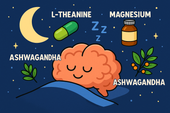
Nootropics That Promote Calm and Rest
Explore the world of calming nootropics — natural brain enhancers that promote relaxation, better focus, and deeper rest. Learn how L-Theanine, magnesium, ashwagandha, and other adaptogens help balance your nervous system, reduce stress, and support restorative sleep.
-

Best Natural Supplement Stack for Sleep
Discover the best natural supplement stack for deep, restorative sleep. Learn how nutrients like magnesium, L-theanine, glycine, and calming herbs such as chamomile and ashwagandha work together to relax your body, calm your mind, and improve sleep quality—naturally and safely.
-

Combining L-Theanine and Magnesium for Sleep: A Calm Night, Naturally
Discover how combining L-Theanine and Magnesium can help you drift into deep, restorative sleep. Learn how this natural duo calms the mind, relaxes the body, and supports your nervous system—without grogginess the next morning.
-

How to Sleep Better After Intense Workouts
Struggling to fall asleep after a tough workout? Learn how to optimize your post-training recovery with nutrition, hydration, and science-backed sleep strategies. Discover how to calm your nervous system, balance hormones, and wake up fully recharged for your next session.
-

Ashwagandha and Valerian: A Bedtime Combo for Deep Rest and Emotional Reset
Discover the calming synergy of Ashwagandha and Valerian root, two natural sleep aids that help quiet the mind, ease anxiety, and promote deeper rest. Learn how this herbal duo supports the nervous system, balances stress hormones, and restores emotional peace — without next-day grogginess.
-

How to Create a Resilience-Boosting Diet
Discover how to build emotional and physical strength from the inside out with a resilience-boosting diet 🍎. Learn which foods stabilize your mood, how supplements like magnesium and omega-3s strengthen your stress response, and why pairing nutrition with breathwork and therapy creates lasting calm, focus, and vitality 🌿💪.
-

Best Teas and Herbal Blends for Calmness: Nature’s Way to Restore Inner Peace
Ashwagandha, the ancient adaptogenic herb, helps your body find balance during stress. Known as “Indian ginseng,” it supports cortisol regulation, boosts energy, and restores calm clarity. Discover how this powerful root promotes resilience, emotional balance, and steady vitality — one cup at a time. 🌸
-

Parenting and Emotional Strength: How to Raise Children Without Losing Yourself
Empathy is the bridge that connects hearts — the quiet power to understand, feel, and support another’s emotions without judgment. Learn how empathy strengthens relationships, enhances communication, and cultivates deeper compassion in everyday life. 🌿
-
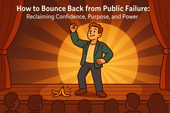
How to Bounce Back from Public Failure: Reclaiming Confidence, Purpose, and Power
Visualization is more than imagination — it’s brain training for resilience. By picturing calm, success, or healing, you activate the same neural pathways as real experience. Learn how daily visualization rewires your brain for confidence, emotional balance, and recovery from stress. ✨
-

Coping with Financial Stress Through Resilience: How to Stay Grounded When Money Feels Tight
Body awareness is the foundation of emotional resilience. By tuning into your body’s signals — tension, fatigue, or calm — you learn to recognize stress before it overwhelms you. Discover how mindfulness, gentle movement, and breathwork can deepen your connection with your body and restore balance from the inside out. 🧘
-

How to Stay Positive During Chronic Illness: A Guide to Emotional Strength and Hope
Creativity is more than art — it’s a form of healing. Whether through painting, writing, music, or small acts of expression, creativity helps release emotion, calm the nervous system, and reconnect you to joy. Discover how to use creativity as a tool for emotional balance, resilience, and self-discovery. 🌿
-
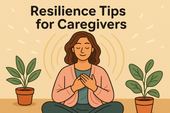
Resilience Tips for Caregivers: How to Stay Strong While Caring for Others
Joy isn’t the absence of pain — it’s the quiet strength to find light even in challenging times. Cultivating joy through small daily moments restores balance, releases stress, and reminds you of life’s beauty. Learn how to reconnect with authentic happiness, rebuild emotional energy, and nurture your nervous system through gratitude, presence, and play. 🌿
-

Building Resilience After a Breakup: How to Heal, Rebuild, and Rise Stronger
Social connection is one of the strongest predictors of emotional resilience. During difficult times, genuine relationships act as anchors — calming the nervous system, reducing stress hormones, and helping you regain perspective. Learn how cultivating real human connection can strengthen your mind, heart, and overall well-being. 🌿
-

How to Stay Emotionally Strong During Job Loss
Your emotions are powered by brain chemistry — a delicate balance of neurotransmitters like serotonin, dopamine, and cortisol. When these chemicals work in harmony, you feel calm, focused, and resilient. Learn how daily habits, nutrition, and mindfulness can support your brain chemistry and boost emotional well-being naturally. 🌿
-
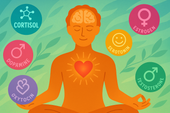
The Role of Hormones in Emotional Stability: How Your Chemistry Shapes Your Calm
Hormones shape more than your body — they shape your emotions, resilience, and sense of calm. From cortisol to serotonin, these chemical messengers influence how you react to stress, connect with others, and recover from challenges. Learn how to balance your hormones naturally to build lasting emotional stability and harmony within. 💫
-

Mitochondria and Emotional Energy: The Cellular Power Behind Your Mood
Breathwork is one of the most powerful tools for emotional regulation and cellular balance. Through intentional breathing, you can calm your nervous system, increase oxygen flow to the brain, and even support mitochondrial energy. Learn how conscious breathing connects body and mind — transforming stress into presence and emotional strength. 🌿
-

Inflammation and Its Impact on Mood Resilience: The Silent Link Between Body and Mind
Inflammation doesn’t just affect the body — it impacts the mind. Chronic inflammation alters brain chemistry, depletes serotonin, and makes emotional recovery harder. Learn how calming inflammation through nutrition, mindfulness, and sleep can restore balance, resilience, and a renewed sense of emotional strength. 💫
-

How Antioxidants Protect Emotional Well-being: The Hidden Link Between Oxidative Stress and Mental Health
Antioxidants do more than protect your body — they defend your mind. By neutralizing oxidative stress, antioxidants support serotonin, dopamine, and brain energy pathways that keep you calm, focused, and emotionally balanced. Discover how foods like berries, green tea, and dark chocolate nourish your brain, boost mood, and strengthen resilience from the inside out. 🌿✨
-
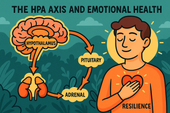
The HPA Axis and Emotional Health: The Hidden Bridge Between Stress and Mind
Neuroplasticity — the brain’s ability to rewire and adapt — is the foundation of emotional healing and resilience. When you face stress, trauma, or change, your neural pathways can reshape themselves to support new patterns of calm, focus, and self-awareness. Learn how daily practices like mindfulness, therapy, and breathwork strengthen neuroplasticity to transform emotional pain into personal growth. 🌸
-
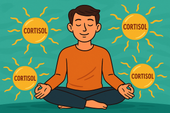
Why Cortisol Control Is Key to Resilience: Mastering Stress to Build Emotional Strength
Controlling cortisol — the body’s main stress hormone — is the secret to lasting resilience. When cortisol levels stay balanced, your mind becomes clearer, emotions steadier, and energy more sustainable. Learn how breathwork, mindset shifts, adaptogens, and daily rhythms can help you calm your stress response and build true inner strength. 🌞💪
-
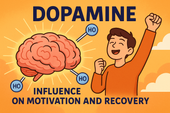
Dopamine’s Influence on Motivation and Recovery: Reigniting Drive and Balance
Healthy relationships are the foundation of emotional balance and resilience. Whether romantic, familial, or platonic, genuine connection releases dopamine, serotonin, and oxytocin — the brain’s “bonding trio” — helping us feel secure, motivated, and seen. Learn how trust, empathy, and communication not only strengthen your connections but also reshape your nervous system for deeper emotional well-being. 🌿🤝
-
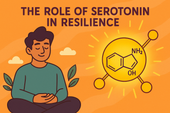
The Role of Serotonin in Resilience: How This “Mood Molecule” Shapes Emotional Strength
Serotonin — often called the “resilience molecule” — plays a vital role in how we handle stress, regulate mood, and recover from emotional challenges. Beyond happiness, this powerful neurotransmitter helps balance the gut-brain axis, stabilize the nervous system, and support emotional flexibility. Learn how nutrition, sunlight, mindfulness, and adaptogens can naturally boost serotonin and strengthen your emotional resilience. 🌞🧠
-

How Neuroplasticity Supports Emotional Growth: Rewiring the Brain for Resilience
Neuroplasticity is the brain’s built-in power to grow, adapt, and heal — and it’s the foundation of emotional transformation. Every mindful breath, compassionate act, or reframed thought strengthens new neural pathways that support resilience and self-awareness. Learn how your brain rewires through daily habits, helping you turn emotional challenges into opportunities for growth and calm. 🌿
-

Tai Chi and Adaptogens for Mind-Body Balance: The Art of Harmonizing Energy and Resilience
Alchemy isn’t just an ancient science — it’s a timeless symbol of transformation and inner balance. By blending the physical and spiritual, alchemy teaches us that change begins from within. Just as metals are refined into gold, we too can transmute emotional pain, stress, and chaos into clarity and strength through mindful practice and self-awareness. 🌙✨
-

Cold Therapy and Emotional Control: Training the Mind Through the Body
Cold therapy isn’t just for athletes — it’s a tool for emotional mastery. By exposing your body to controlled cold, you train your nervous system to stay calm under stress, improving focus, mood, and resilience. This article explores the science of cold exposure, its impact on hormones and the vagus nerve, and how ice baths and cold showers can help you build emotional control, one breath at a time. 🧊🧘♂️
-

How Music Influences Emotional Recovery: The Healing Soundtrack of the Mind
Neuroplasticity — the brain’s ability to rewire and heal itself — is at the heart of emotional recovery. Through mindful habits, music, therapy, and consistent mental stimulation, your brain can form new connections that support resilience and well-being. Discover how neuroplasticity turns pain into growth, helping you rebuild balance, focus, and emotional strength. 🌿
-
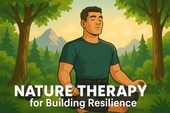
Nature Therapy for Building Resilience: Reconnecting With the Healing Power of the Earth
Nature therapy helps rebuild emotional resilience by reconnecting you with the healing rhythms of the Earth. From forest walks to sunlight exposure, nature restores balance to your nervous system, lowers stress hormones, and teaches emotional adaptability. Learn how spending time outdoors can enhance mental clarity, calm anxiety, and awaken your natural capacity to heal. 🌞
-

Breathwork Techniques That Pair with Supplements: The Ultimate Synergy for Stress Relief and Mental Clarity
Breathwork and supplements create a powerful mind-body synergy for stress relief, focus, and energy. By combining intentional breathing with adaptogens, nootropics, and calming nutrients, you can naturally regulate cortisol, sharpen mental clarity, and boost emotional balance. This guide explores the best breathwork techniques and supplement pairings to help you feel centered, calm, and energized from the inside out. 🌿

















































